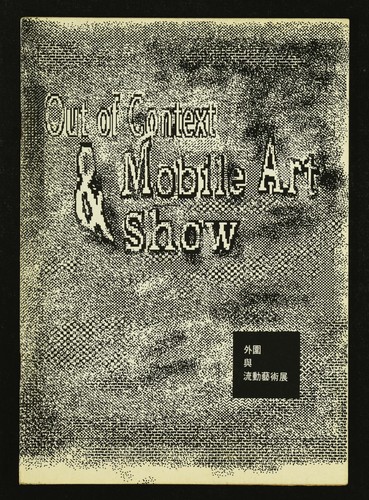藝評
一個舊展覽的啟示 Learning from a public art exhibition
何慶基 (Oscar HO)
at 4:20pm on 22nd October 2024

(An article by Oscar Ho in Chinese & English discussing why cultural workers should understand that people have many interests and priorities - not necessarily artistic) - Scroll down for English
Above image: Front cover of exhibition catalogue for 'Out of Context' and 'Mobile Art' exhibitions, 1988
一個舊展覽的啟示
何慶基
八十年代後期,本地新一代藝術工作者不滿當前藝術界的封閉保守,躍躍欲試開拓新的藝術領域。繼《外圍》這另類藝術展後,部份參與該展覽的藝術工作者加上些新成員,決定把藝術帶入社群,打破藝術遠離公眾的死局。*
1988年的《流動藝術展》由陸恭蕙、祈大偉和我聯合策劃,約同一群本地藝術工作者如 黃仁逵、麥顯揚、陳志玲、蔡仞姿、梁以瑚、王和璧等,還有包括胡恩威在內 的一群港大學生。展覽分別於週末期間,在屯門及旺角的公園球場展出,參展 者大都是現場製作繪畫和裝置(例如王和璧搭建巨型針孔照相機)。展覽首先在 屯門一個小公園展出,公眾大都不明所以,但也沒太大反感,反而小孩子倒十 分享受種種怪異的藝術裝置,並參與一些繪畫工作。
其後另一週末,展覽移師旺角麥花臣球場。全憑陸恭蕙,我們取得各式各樣的許可證,可以在球場上正式攪藝術活動。當我們走進麥花臣的籃球場時,一群年⻘人正興高彩烈地在打球,我們早獲批准使用該空間,當然有權要求他們離場,但當時湧上心頭的問題是:「我們憑什麼覺得自已的藝術比人家打籃球更加重要?」藝術界人士很自然地以為藝術是很優秀的東⻄,所有人都應該欣賞和參與。但人家自有自已的喜好,為何強加於人?藝術不是大哂的,創意、技術也並非藝術創作所獨有,為何要終止人家的活動來遷就你這個叫「藝術」的東⻄。突然發覺攪藝術的人,不少在骨子裡都有份自大的高傲,以為自已有優越的東⻄,可以慷慨輸送與那些等待提升的無知大眾。或許需要教育的,是文化工作者本身。

Basketball players (and carer and grandma & their shadow), Southorn Playground, Wan Chai, Hong Kong, 2021 (photo: John Batten)
在公共空間攪展覽的挑戰,是場地原本不是個供展覽用的空間,內裡的人也不 是刻意走來看展覽的藝術觀眾,那場地有它原有的功能(在這裡是個體育的場 地),某程度上,強行把藝術帶進這空間是一種侵犯,因為觀者很多時候是在進 行其他活動時被迫觀看這些藝術,因此對公眾的感受尤要敏感。公共藝術 public art與在公共空間的藝術art in public space不同,後者只是放在公共空間的 藝術,但前者是關注與公眾互動關係,考慮到那些非藝術館觀眾的喜好取捨。文化工作者很自然會地相信自已創作或策劃的,是最好的東⻄,急於向人家推介。更有甚者,是如果人家不感興趣,必積極予以「教化提升」,猶如阿媽迫子女吃苦茶,苦口良藥,無知小孩又怎明白。我們有機會接觸優美的藝術,希望人家分享當然是用心良苦,但人家不喜歡你的東⻄又怎麼辦?抽象藝術的複雜理念、文人山水畫的優雅情趣,對很多人來說,根本與他們的成長、學習以至生活經驗完全扯不上關係。普羅大藝術欣賞有強烈的階級性,策展人或藝術家沒有這觸覺,動不動便「教化」人家,不單是浪費精力,也是對人家的侮辱。
*See the archive held at Asia Art Archive:
https://aaa.org.hk/en/collections/search/archive/out-of-context-research-project
Learning from a public art exhibition
by Oscar Ho
In the late 1980s, a new generation of local artists, dissatisfied with the closed and conservative nature of Hong Kong’s art world, were eager to explore new artistic horizons. At the end of “Out of Context”*, an alternative art exhibition held at 15 Kennedy Road in Wan Chai, some of the participating artists and some new members, decided to bring art into the community and break the deadlock of art's isolation from the public.
In 1988, the Mobile Art Exhibition was jointly organized by Christine Loh, David Clarke and myself, with a group of local artists, including Wong Yan Kwai, Mak Hin Yeung, Chan Chi Ling, Choi Yan Chi, Leung Yee Woo, Wong Wo Bik and a group of students from the University of Hong Kong, including Woo Yan Wai. The exhibitions were held in parks in Tuen Mun and Mong Kok during weekends, with most participants making on-site paintings and installations (for example, Wong Wo Bik's construction of a giant pinhole camera). The exhibition was first held in a small park in Tuen Mun - with the public more confused than shocked by the artwork! On the contrary, children enjoyed the strange art installations and took part in some of the painting work.

Basketball players, Southorn Playground, Wan Chai, Hong Kong, 2024 (photo: John Batten)
Later, the exhibition moved to the MacPherson Stadium in Mong Kok. Christine Loh, the future legislator, assisted obtaining a variety of permits to use the sports stadium for art activities. When we walked onto the stadium’s basketball court, a group of young men were enthusiastically playing basketball. As we had permission to use the space, we had the right to ask them to leave, but the question that came to mind was, “Why do we think our art is more important than people playing basketball?
It is natural for people in the arts community to think that the arts are a great thing and should be appreciated and participated by everyone. But, people have their own preferences, so why impose them onto others? Art is not for everyone, and creativity and technique are not unique to artistic creation, so why should we stop other people''s activities to accommodate our “art”?
Suddenly, I realised that many people who are involved in art are arrogant and haughty at heart, thinking that they are superior and that they can generously transfer to the “ignorant masses”, who are waiting to be educated. Perhaps it is the producers of art themselves who need to be educated.
The challenge of creating an exhibition in a public space is that this venue is not originally an exhibition space, and the people inside are not art-goers that intentionally visit to see an exhibition. The venue has its original function (in this case, it is a sports venue), and to a certain extent, it is an intrusion to forcibly bring art into the space, as the viewers are often forced to see the art while they are engaged in other activities – therefore, public art should be particularly sensitive to the feelings of the general public.
Public art is different from art in public spaces in that the latter is art in public space, but the former is concerned with interaction with the public, taking into account the preferences of a non-museum audience.
Cultural workers naturally believe that what they create or curate is the best, and are eager to promote it to others. What's more, if people are not interested, the curators will actively “educate and promote” their art shows, just like a mother forcing her children to take bitter herbal medicine, but how can an ignorant child understand the benefits of bitter medicine?
It is, of course, well-intentioned to expect art to be shared with the public, but what can be done if the public does not like the work? The complex concepts of abstract art and the elegance of literati landscape paintings have nothing to do with many people's upbringing, their studies and life experiences. There is a strong hierarchical attitude in the appreciation of popular art. Curators and artists do not have the sensibility to appreciate the values of popular culture.
*See the archive held at Asia Art Archive:
https://aaa.org.hk/en/collections/search/archive/out-of-context-research-project
